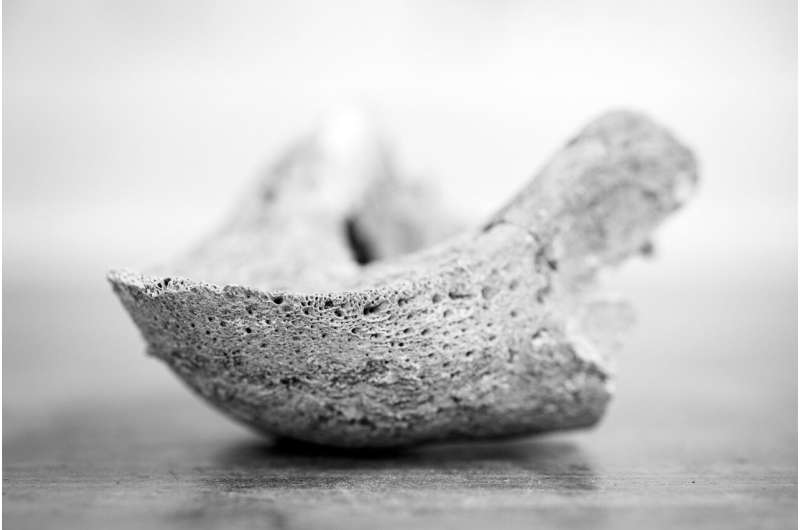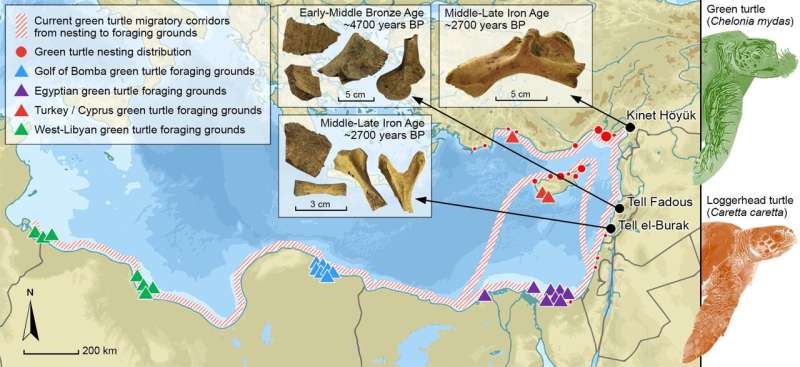This article has been reviewed according to Science X's editorial process and policies. Editors have highlighted the following attributes while ensuring the content's credibility:
fact-checked
peer-reviewed publication
trusted source
proofread
Green sea turtles have traveled to the same place to eat for 3,000 years, discovers ecologist

For approximately 3,000 years, generations of green sea turtles have returned to the same seagrass meadows to eat.
This was discovered by Willemien de Kock, a historical ecologist at the University of Groningen, by combining modern data with archaeological findings.
Sea turtles migrate between specific breeding places and eating places throughout their lives–this much was known. But the fact that this stretches over many generations highlights the importance of protecting seagrass meadows along the coasts of North Africa. The results were published in PNAS on July 17.
When young green sea turtles hatch, their parents have already left for a long journey. The little turtles clumsily make their way off the beach into the ocean and, not yet able to navigate the long migration of their parents, float around for years. During this time, they are not very picky eaters, omnivores even. Then, at about five years of age, they swim to the same area where their parents went, to eat a herbivore's diet of seagrass.
Along the coasts of the eastern Mediterranean Sea, volunteers are active to protect the nests of the endangered green sea turtles. However, as Willemien de Kock explains, "We currently spend a lot of effort protecting the babies but not the place where they spend most of their time: the seagrass meadows." And crucially, these seagrass meadows are suffering from the effects of the climate crisis.

Analyzing sea turtle bones
In the attic of the Groningen Institute of Archaeology at the University of Groningen, De Kock had access to boxes full of sea turtle remains from archaeological sites in the Mediterranean Sea area. The excavations were already done by her supervisor, Dr. Canan Çakırlar. "All I had to do was dig in some boxes," De Kock says. By analyzing the bones, De Kock was able to distinguish two species within the collection of bones: the green sea turtle and the loggerhead turtle.
De Kock was also able to identify what the sea turtles had been eating. This relied on a substance called bone collagen. By inspecting the bone collagen with a mass spectrometer, De Kock could detect what kind of plants the sea turtles must have eaten. "For instance," De Kock explains, "one plant might contain more of the lighter carbon-12 than another plant, which contains more of the heavier carbon-13. Because carbon does not change when it is digested, we can detect what ratio of carbon is present in the bones and infer the diet from that."

Combining old and new
Modern satellite tracking data from the University of Exeter then provided De Kock with information on the current traveling routes and destinations of sea turtles.
Researchers from Exeter had also been taking tiny samples of sea turtles' skins, which revealed similar dietary information as De Kock found in bones. De Kock was, therefore, able to draw conclusions, connecting diets of millennia ago to specific locations. She found that for approximately 3,000 years, generations of green sea turtles have been feeding on sea grass meadows along the coasts of Egypt and West Libya. The results for loggerhead turtles were less specific because they had a more varied diet.
So, why is it relevant to know the eating habits of a species over many past generations? Because we collectively suffer from the shifting baseline syndrome: slow changes in a larger system, such as an animal population, go unnoticed because each generation of researchers redefines what the natural state was, as they saw it at the start of their careers.
"Even long-term data goes back only about 100 years," says De Kock. "But tracing back further in time using archaeological data allows us to better see human-induced effects on the environment. And it allows us to predict, a bit." In fact, recent models have shown a high risk of widespread loss of seagrass in precisely these spots where green sea turtles have been going for millennia. This could be detrimental to the green sea turtle, precisely because of its high fidelity to these places.
More information: de Kock, Willemien, Threatened North African seagrass meadows have supported green turtle populations for millennia, Proceedings of the National Academy of Sciences (2023). DOI: 10.1073/pnas.2220747120
Journal information: Proceedings of the National Academy of Sciences
Provided by University of Groningen





















